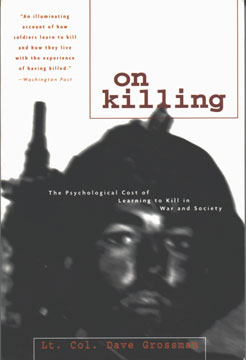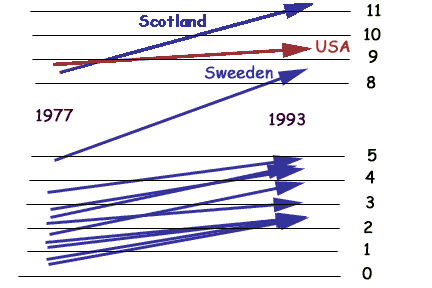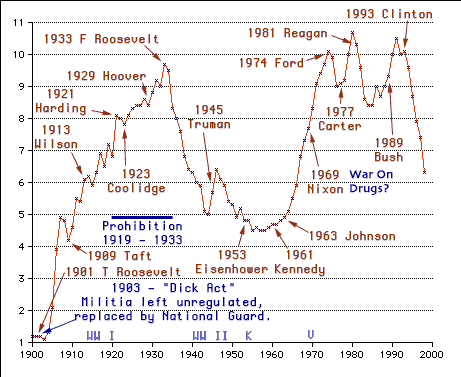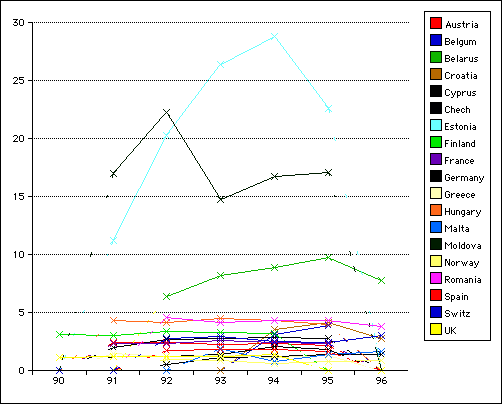 |
The Psychological Cost of Learning
to Kill
in War and Society
Questioning the First Amendment
 |
The Psychological Cost of Learning
to Kill
in War and Society
Questioning the First Amendment
The rest of these pages are focused on the gun control v. Second Amendment debate. Lt. Col. Dave Grossman is concerned with a different conflict. Prior to the Korean war, a large majority of soldiers in the front lines would not kill. They would either not fire, or deliberately fire high. Simulations and analysis of battles confirms this. Knowing the power and accuracy of weapons, and ammunition expended, if soldiers had intended to kill their casualties would have been much higher.
General George Marshall became very aware of this problem during World War II. He developed training programs which to a great degree solved the problem by the Vietnam War. Training was designed specifically to confirm the moral right to take lives. Part of it was establishing authority, and emphasizing the duty to country and one's unit. Part of it was establishing a moral and emotional distance between the soldier and the enemy. Part of it was simply repeating the motions that the soldier must follow when under stress.
The lesson that the drill sergeant teaches is that physical aggression is the essence of manhood and that violence is an effective and desirable solution for the problems that the soldier will face on the battlefield. But it is very important to understand that the drill sergeant also teaches obedience. Throughout training the drill sergeant will not tolerate a single blow or a single shot executed without orders, and even to point an empty weapon in the wrong direction or to raise your fist at the wrong time merits the harshest punishment. No nation will tolerate soldiers who do not obey orders on the battlefield, and the failure to obey orders in combat is the surest route to defeat and destruction.
The result was a much more effective army. However, one side effect was a vast increase in post traumatic stress. The training emphasized the authority and duty to kill. However, if the community does not confirm the moral right to kill after the fact, post traumatic stress is greatly increased.
This is a highly recommended book for anyone considering a career in the military or police service, if one is suffering post traumatic stress, or simply if there is a combat veteran in one's family. It covers ground that should be covered.
Grossman is also concerned that the modern media is duplicating the style and effects of the military training. Vivid depiction of death in movies and TV might reduce the inhibition against killing that is part of one's normal cultural and genetic heritage. Doom and other similar first person shooter arcade games might act as conditioning exercises. When under stress, one tends to repeat prior trained behavior. First person shooters might condition killing. Thus, it follows that we must reduce violence in the media, and in our games.
The ever-ascending tide of violence in our society must be stopped. Each act of violence breeds ever-greater levels of violence, and at some point the genie can never be put back in the bottle. The study of killing in combat teaches us that soldiers who have had friends or relatives injured or killed in combat are much more likely to kill and commit war crimes. Each individual who is injured or killed by criminal violence becomes a focal point for further violence on the part of their friends and family. Every destructive act gnaws away at the restraint of other men. Each act of violence eats away at the fabric of our society like a cancer, spreading and reproducing itself in ever-expanding cycles of horror and destruction. The genie of violence cannot really ever be stuffed back into the bottle. It can only be cut off here and now, and then the slow process of healing and resensitization can begin...To fail to do this leaves us with only two possible results: to go the route of the Mongols and the Third Reich, or the route of Lebanon and Yugoslavia. No other result is possible if successive generations continue to grow up with greater and greater desensitization to the suffering of their fellow human beings. We must put the safety catch back on our society.
Grossman isn't strong on statistics. He is strong on anecdotal evidence. One chart, copyrighted, qualifies him for the liars sure figure pages.
 |
|
Homicides / 100,000 population Red is USA, Blue other countries. From "Interpol's biannual International Crime Statistics |
The arrows represent the US, Scotland, Sweden, Hungary, France, India, Australia, Denmark, Belgium, New Zealand, England / Wales, Greece, Norway and Spain. Most of the arrows are too close together for labeling. However, let's compare Grossman's Interpol numbers to the UN report used by myself and Gunfree. Note, Grossman provides a copyrighted chart with no absolute numbers. My reading values off his chart may not be totally accurate, but should be within two tenths. The UN numbers are a few years later. My number for the USA is a full five years later. Still...
|
|
|
|
|
|
|
|
|
|
|
|
|
|
|
|
|
|
|
|
|
|
|
|
|
|
|
|
|
|
|
|
|
|
|
|
|
|
|
|
|
|
|
|
|
|
|
|
|
|
|
|
|
|
|
I don't feel confident comparing numbers from two different sources. Perhaps the UN and Interpol use different definitions of 'homicide?' Perhaps Grossman used a different set of population figures? Perhaps the biannual Interpol numbers reflect a two year average? I do know his numbers from the United States do not match the US Bureau of Justice numbers. 1977, Grossman shows 8.8, BOJ 9.1. 1993 Grossman shows 9.5, BOJ 10.1. It is easy to forgive a difference of less than 1 in a given year. Sweeden's factor of four difference in a single year feels wrong. Also, Grossman makes a point that every single country he lists went up over his 16 year period. Most went down in the next two.
The overall effect of Grossman's 16 year period was an increase, as the DoJ numbers also show. Problem is, during the period specified, the height of the War on Drugs, the US rates were bouncing up and down by precisely the amount shown on Grossman's chart. It seems that every time the US shifted presidents, the homicide curve bounced in a different direction. If one chose one's years, one could produce evidence of Grossman's magnitude either supporting or denying Grossman's position. My own reading of the 20th Century US Homicide rate is that disarming the people adds about 5 per 100,000 to the homicide rate, while attempting to control mind altering substances adds another 5 per.
 |
In an attempt to get some independent verification of a world wide homicide rate increase, these are all the numbers for all the years in the UN report for Europe. Sweden is out as it had only one year. Monaco is out as it reported zero homicides. Many other countries did not report to the UN. As shown, the countries which did report did not all report all years.
|
|
|
|
|
|
|
|
|
|
|
|
|
|
|
|
|
|
||
|
|
|
|
|
|||||
|
|
|
|
|
|
|
|
||
|
|
|
|
|
|
||||
|
|
|
|
|
|
|
|
||
|
|
|
|
|
|
|
|
||
|
|
|
|
|
|
|
|
||
|
|
|
|
|
|
|
|
||
|
|
|
|
|
|
|
|
||
|
|
|
|
|
|
|
|
||
|
|
|
|
|
|
|
|
||
|
|
|
|
|
|
|
|
||
|
|
|
|
|
|
|
|||
|
|
|
|
|
|
|
|
||
|
|
|
|
|
|
|
|
||
|
|
|
|
|
|
|
|
||
|
|
|
|
|
|
|
|||
|
|
|
|
|
|
|
|
||
|
|
|
|
|
|
|
|
 |
|
|
There is an upward trend overall. 10 of 19 countries have an increasing rate. The average increase is 0.73, which is quite respectable. This might support Grossman's thesis.
However, the former Soviet countries, Estonia, Belarus and Moldova, are not representative of the rest of Europe. All other countries stay nicely in the 0.5 to 5 range. The former Soviets are in the 7 to 28 range. Without the former Soviets, the average increase is 0.06, which gets lost in the noise. Excluding the Soviets, only 7 of 19 countries have an increasing homicide rate. The difference between the former Soviet countries and the rest of Europe is not likely best attributed to violent movies and video games. Especially during this time frame, social and economic unrest seems the more likely cause.
The UN study above shows only 5-7 years. This is not long enough to pick up the long term trend. Grossman might still have the better numbers and be right. Still, I can't see it. While we may have a problem with media and game violence, it isn't showing up as an end of the world crisis panic. Of course, no matter what one's interests are, most everyone involved is ready to push the panic button. Whether you listen to Gunfree, the NRA, Bradley, or Grossman, the emotional language is laid on very heavy.
A few hundred data points is enough to be suggestive, especially if one edits and/or carefully selects the numbers presented. A few hundred data points is not enough to isolate causes. Gun policy, alcohol, drugs, race, economics and increasing population density might all reasonably effect homicide rates. Looking at the bottom line numbers tells you what happens, but does not begin to tell why. In answering a values oriented question such as responsibility for defense, one's core values are apt to infer how data is interpreted. If one doesn't have a massive data base sufficient to control out other variables, no matter how sincerely one believes in one's numbers, an opponent with conflicting values might sincerely cling to a different set of numbers. Thus far, only John Lott's More Guns Less Crime has the massive data base sufficient for such controls. The other factions must carefully edit and spin their data to make their cases sound convincing.
I shall end with a few of Grossman's less extreme pleas for limiting the presentation of violence to our youth. I distrust Grossman's statistics. Alas, my favorite search engines seem unable to find copies of Interpol's biannual reports, Grossman's quoted source. They seem not to be posted. (If anyone has access to the reports, and is willing to mail me enough data to confirm or deny Grossman's numbers, please e-mail me.) While his numbers may be twisted or selective, he feels solid when he stays firmly in his military specialty areas. I still recommend the book.
There is no more need to constrain the print media than there is to control bowie knives, tomahawks, or flintlock rifles, but there might just be a justification for controlling the technology that goes beyond print media and flintlocks. The more advanced the technology, the greater the need for control. In the realm of weapons technology that means controlling explosives, artillery, and machine guns, and it may mean that the time has come to consider controlling assault rifles or pistols. In the realm of media technology, that may mean that the time has come to consider controlling TV, Movies and video games...There is a sound argument for changing the way we view and apply First Amendment rights, but I do not advocate it. I do, however, believe that the time has come for our society to censure (not censor) those who exploit violence for profit. In A.M. Rosenthal's words we must "turn entirely away from those ugly people, defeating them by refusing them tolerance or respectability."
On Killing, Amazon.com reviews.
|
|
More Guns Less Crime - USA - World On Killing - White House Study - Children |